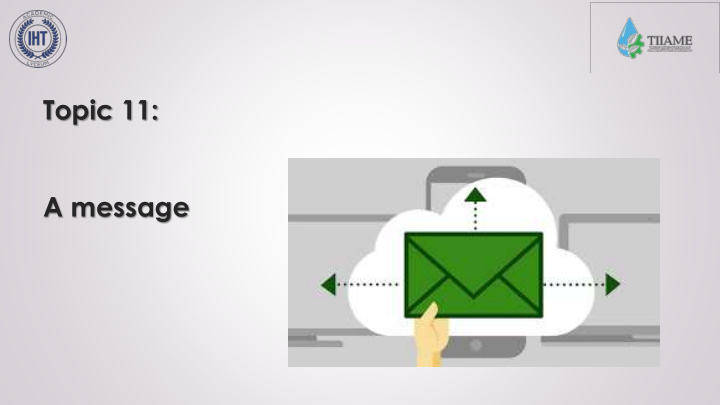



Topic 11: A message
What Is a Message in Communication?
In rhetorical and communication studies, a message is defined as information conveyed by words (in speech or writing), and/or other signs and symbols. A message (verbal or nonverbal, or both) is the content of the communication process. The originator of the message in the communication process is the sender. The sender conveys the message to a receiver.
Verbal and Nonverbal Content Intentionally or not, both verbal and nonverbal content is part of the information that is transferred in a message. If nonverbal cues do not align with the verbal message, ambiguity is introduced even as uncertainty is increased
A message may include verbal content, such as written or spoken words, sign language, email, text messages, phone calls, snail-mail, and even sky-writing A message will also include nonverbal content, such as meaningful behavior beyond words. This includes body movement and gestures, eye contact, artifacts, and clothing, as well as vocal variety, touch, and timing
THE DIFFERENT TYPE OF MESSAGES When interacting with your system, your users will come across different types of messages, and you need to display these correctly to communicate the meaning behind them. I wrote a while ago about bad error messages, but there are other types of messages. Types of messages: Confirmation Messages Information Messages Warning Messages Error Messages System Messages
Confirmation Messages These are messages which require users to confirm an action they are trying to perform. When a user performs an update action there is generally no need to display a confirmation message, but you would display them when they are: Deleting an item (Are you sure you want to delete ) Attempting to exist a screen with unsaved changes (Do you wish to save changes?) Use this type of messages to communication information that they must confirm before the action is completed. Use sparingly as to not slow down the intended action with unnecessary confirmation.
Confirmation Messages
Information Messages When a user completes an action, an Information message is sometimes displayed which confirms that the action/task has been completed successfully. For example: Successfully deleted Item updated Changes saved In a Windows desktop environment you usually see Information messages with a symbol is a blue circle with a white letter 'i'. On the web these might display as a banner along the top of the screen or a toaster dialog that goes away automatically without user interaction. These messages should display often when a change in state is made so that the user has feedback and know their intended action occurred.
Information Messages
Warning Messages When a user performs an update action that will cause updates in other parts of the system a warning message should display, advising user of the consequences of the action. A prompt for 'do you wish to proceed' should be used so user can back out of the action. In a Windows desktop environment you usually see warning messages with a symbol is a yellow triangle with black exclamation mark.
Warning Messages
Error Messages When a user performs an update that breaks field level validation, screen validation, or a business rule, an error message should be displayed advising exact cause of error and remedial action required. Error messages should be easy to understand and fix. In a Windows desktop environment errors often display with a red circle and white cross but this is very dramatic and scares users. Rules for writing good error messages are available here.
Error Messages
System Messages Ideally, a user will rarely see a pure system message, such as a HTTP response, database error, or system failure. These messages should be considered bugs and require error handling to be coded as one of the other types of error messages. Make sure HTTP errors are intercepted and something user friendly is display to the user explaining what 403 (Forbidden) 404 (not found), 503 (service not available) etc. actually means
System Messages
Write how you can avoid each of these types of message ?
Recommend
More recommend